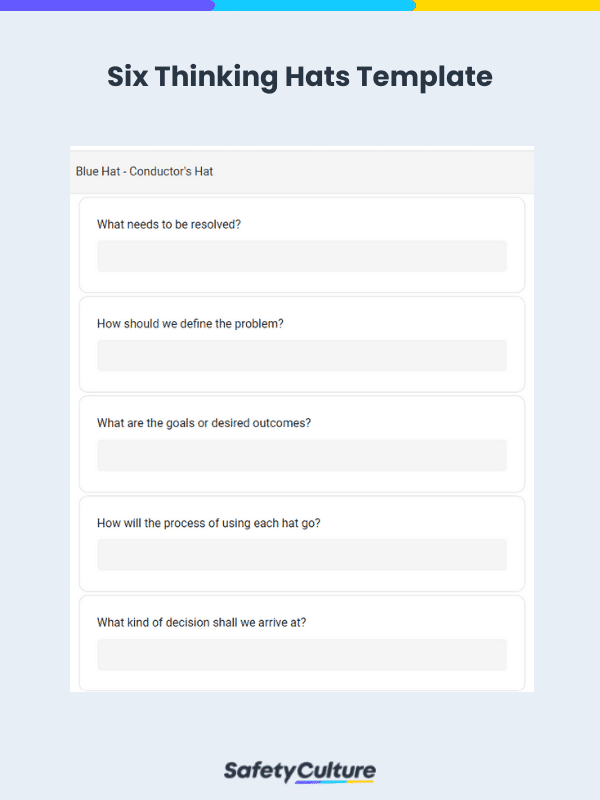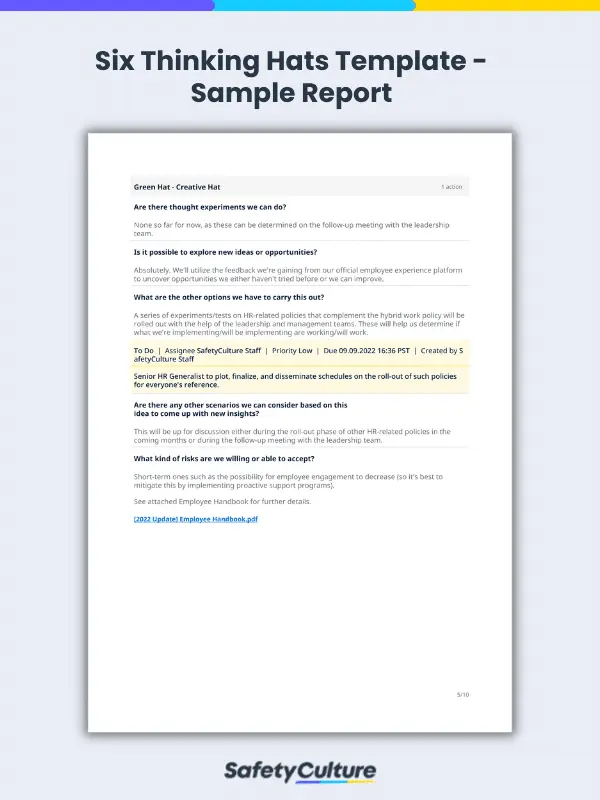What is a Six Thinking Hats Template?
A six thinking hats template is a tool used in brainstorming, planning, decision-making, and problem-solving sessions or discussions that helps provide an easier way of looking at ideas and solutions through different perspectives using guide questions under each of the six thinking hats. This tool is designed to help discuss, probe, and gauge an idea or problem further using the six thinking hats technique developed by Dr. Edward de Bono in 1985.
Importance
Each of the six thinking hats serves a different purpose or mode of thinking. When used by teams or during group discussions, it’s important to ensure that everyone uses the same hat at the same time. Its essence is to help avoid unnecessary conflicts between the various modes of thinking and follow a set structure or order of using the hats in resolving problems or addressing situations. By using a six thinking hats template, the facilitator can easily keep everyone reminded to use the same hat simultaneously since it also helps dictate the flow of the discussion.
On the other hand, it’s also crucial to use guide questions that are aimed to be answered when each thinking hat is being used. While these questions can be customizable to fit different scenarios, ensuring that they stick to the central theme or representation of each hat is key to achieving the ultimate goal when using or “wearing” a specific hat. A 6 thinking hats template walks you through each hat using guide questions to help you account for details and important data needed for the problem being solved or project or idea being explored.
What Should be Included in a Six Thinking Hats Template?
In order to make the use of the six thinking hats technique more effective, having a standard template is encouraged. Even more so, it helps ensure that no thinking hat—blue for organizing and planning, white for gathering facts, green for fostering creativity, yellow for establishing value, red for recognizing feelings, and black for identifying risks—is overlooked or unused in the process.
Hence, here are the key details and sections you must include:
Title Page
The first page of your six thinking hats template should include basic details about the project or idea being explored. Hence, allot this page for the following information:
- Meeting Date
- Facilitator
- Meeting Location
- Project Name/Idea/Problem
Separate Pages for Each Thinking Hat
- Blue Hat – Conductor’s Hat; represents organization and planning through agenda setting and the sequence of using the succeeding hats
- White Hat – Factual Hat; discusses all available and needed information as well as its key sources that will help evaluate and validate an idea, concept, or project
- Green Hat – Creative Hat; responsible for idea generation and conceptualization
- Yellow Hat – Value Hat; looks at the positive aspects and identifies the benefits and values
- Red Hat – Intuitive Hat; explores the emotions and feelings for and about the topic being discussed or addressed
- Black Hat – Cautious Hat; takes into account the negative implications of the project with the aim to take steps in mitigating the risks or consequences involved
This recommended process by TSW Training helps you effectively use the six thinking hats in a logical order, but you can always customize it the way you, your team, and your organization need it.
Completion
Lastly, allot the final page of your template for the following details:
- Notes
- Recommendations and Next Steps
- Sign-off
Six Thinking Hats Template Example
To help you better understand what this template looks like, here’s a six thinking hats example when you use it in SafetyCulture:
FAQs About Six Thinking Hats Templates
Six thinking hats templates can be used by anyone who’s in charge of or involved in brainstorming sessions, planning stages, and decision-making processes in an organization or a team. Often, meeting leaders or facilitators widely use such templates to help streamline the overall process of the brainstorming or planning session.
Using each section of the six thinking hats template, members of the meeting answer guide questions to help them further analyze or evaluate an idea or problem. Such questions are crucial in making the discussion flow smoothly and ensuring every perspective is considered.
Generally, using the six thinking hats technique along with a well-crafted template for it lets you:
- Look at and probe different problems, ideas, and concepts from six various perspectives more efficiently using the guide questions under each thinking hat stated in the template;
- Establish a reliable way of recording ideas, factors to consider, possible risks to face, and other details relevant to the overall project or idea being explored;
- Practice parallel thinking among the team which can bring about favorable results in collaboration; and
- Encourage everyone involved in the session to think outside the box and wear the thinking hats more intentionally.




